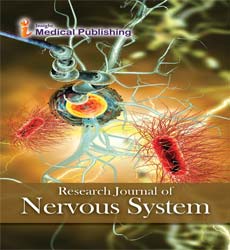The Discharge of Transmitters Autonomic Nervous Gadget to Stimulate Neurons
Joseph R Berger *
Department of Neurology, Perelman School of Medicine, University of Pennsylvania, Philadelphia
*Corresponding author: Joseph R. Berger, Department of Neurology, Perelman School of Medicine, University of Pennsylvania, Philadelphia; E-mail: joseph.berger@pennmedicine.upenn.edu
Received date: November 01, 2021; Accepted date: November 15, 2021; Published date: November 22, 2021
Citation: Berger J (2021) The Discharge of Transmitters Autonomic Nervous Gadget to Stimulate Neurons. J Nerv Syst Vol.5 No.5: 015.
Description
The autonomic nervous gadget features to adjust the body's unconscious moves. The sympathetic worried system's number one technique is to stimulate the frame's combat or flight response. It is, however, continuously lively at a simple level to hold homeostasis. The sympathetic frightened device is described as being opposed to the parasympathetic frightened machine which stimulates the frame to at the synapses within the ganglia; preganglionic neurons release acetylcholine, a neurotransmitter that turns on nicotinic acetylcholine receptors on postganglionic neurons. In response to this stimulus, the postganglionic neurons launch norepinephrine, which activates adrenergic receptors which might be present on the peripheral target tissues. The activation of goal tissue receptors reasons the results associated with the sympathetic gadget. but, there are three important exceptions Postganglionic neurons of sweat glands release acetylcholine for the activation of muscarinic receptors, except for areas of thick pores and skin, the palms and the plantar surfaces of the toes, in which norepinephrine is released and acts on adrenergic receptors. These results in the activation of sudomotor feature which is classified.
Postganglionic sympathetic nerves
Electrochemical pores and skin conductance cells of the adrenal medulla are analogous to submit-ganglionic neurons; the adrenal medulla develops in tandem with the sympathetic nervous gadget and acts as a changed sympathetic ganglion. Inside this endocrine gland, preganglionic neurons synapse with chromaffin cells, triggering the discharge of transmitters: a small share of norepinephrine, and extra considerably, epinephrine. The synthesis and launch of epinephrine rather than norepinephrine is any other distinguishing feature of chromaffin cells as compared to postganglionic sympathetic neurons. Postganglionic sympathetic nerves terminating in the kidney release dopamine, which acts on dopamine receptors of blood vessels to control how a good deal blood the kidney filters. Dopamine is the immediate metabolic precursor to norepinephrine, but is nevertheless a awesome signaling molecule. Sympathetic nerves stand up from close to the middle of the spinal cord inside the intermediolateral nucleus of the lateral gravy column, beginning at the primary thoracic vertebra of the vertebral column and are thought to increase to the second one or third lumbar vertebra. Due to the fact its cells begin within the thoracolumbar department the thoracic and lumbar areas of the spinal cord the sympathetic fearful device is said to have a thoracolumbar outflow.
Neurotransmitter Synaptic Transmission
Axons of these nerves depart the spinal twine the anterior root. They skip near the spinal (sensory) ganglion, where they enter the anterior rami of the spinal nerves. but, not like somatic innervation, they fast separate out through white rami connectors so called from the vibrant white sheaths of myelin round each axon that connect with both the paravertebral. Which lie close to the vertebral column paravertebral which lie close to the aortic bifurcation ganglia extending alongside the spinal column. To attain target organs and glands, the axons need to tour long distances within the body, and, to perform this, many axons relay their message to a 2d mobile synaptic transmission. The ends of the axons link across a space, the synapse, to the dendrites of the second one mobile. The primary cell sends a neurotransmitter throughout the synaptic cleft in which it activates the second cell. The message is then carried to the very last destination. Scheme displaying structure of presynaptic nerves’ axons terminates in either the paravertebral ganglia or paravertebral ganglia. There are four exclusive paths an axon can take earlier than attaining its terminal. In all instances, the axon enters the paravertebral ganglion at the level of its originating spinal nerve. After this, it is able to then both synapse in this ganglion, ascend to an extra superior or descend to a greater inferior paravertebral ganglion and synapse there, or it could descend to a paravertebral ganglion and synapse there with the postsynaptic cell.
Open Access Journals
- Aquaculture & Veterinary Science
- Chemistry & Chemical Sciences
- Clinical Sciences
- Engineering
- General Science
- Genetics & Molecular Biology
- Health Care & Nursing
- Immunology & Microbiology
- Materials Science
- Mathematics & Physics
- Medical Sciences
- Neurology & Psychiatry
- Oncology & Cancer Science
- Pharmaceutical Sciences
